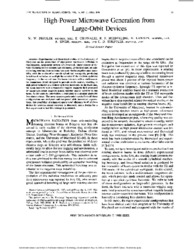| dc.contributor.author | Destler, William | |
| dc.contributor.author | Chojnacki, E. | |
| dc.contributor.author | Hoeberling, R. | |
| dc.contributor.author | Lawson, W. | |
| dc.contributor.author | Singh, A. | |
| dc.contributor.author | Striffler, C. | |
| dc.date.accessioned | 2009-05-19T14:54:30Z | |
| dc.date.available | 2009-05-19T14:54:30Z | |
| dc.date.issued | 1988-04 | |
| dc.identifier.citation | W.W. Destler, E. Chojnacki, R.F. Hoeberling, W. Lawson, A. Singh, and C.D. Striffler, "High Power Microwave Generation from Large Orbit Devices," IEEE Trans. Plasma Sci. (Special Issue on High Power Microwaves), 16 , 71 (1988). | en_US |
| dc.identifier.uri | http://hdl.handle.net/1850/9596 | |
| dc.description | ©1988 IEEE. Personal use of this material is permitted. However, permission to reprint/republish this material for advertising or promotional purposes or for creating new collective works for resale or redistribution to servers or lists, or to reuse any copyrighted component of this work in other works must be obtained from the IEEE. This article can also be found on the publishers website: http://ieeexplore.ieee.org/xpl/RecentIssue.jsp?punumber=27 | en_US |
| dc.description.abstract | Experimental and theoretical studies at the University of
Maryland on the production of high-power microwave radiation in
cusp-injected, large-orbit devices are reviewed. Three classes of devices
belonging to this category are discussed. In the first case, an axis encircling
rotating electron beam interacts via the negative mass instability
with the modes of a smooth cylindrical waveguide, producing
broad-band radiation at multiple harmonics of the electron cyclotron
frequency. In the second case, the beam interacts with a multi resonator
magnetron circuit designed to provide mode control, resulting in
high-power radiation at a desired cyclotron harmonic. In the third case,
the beam interacts with a transverse wiggler magnetic field produced
by samarium-cobalt magnets placed interior andlor exterior to the
beam. In this case the interaction is analogous to a circular geometry
free-electron laser, The most recent experimental results from all three
configurations are reviewed and compared with theoretical expectations.
The possibility of enhanced operational efficiency in all of these
devices by electron energy recovery is discussed, and a design for a
first experiment to test this concept is presented. | en_US |
| dc.language.iso | en_US | en_US |
| dc.publisher | IEEE | en_US |
| dc.relation.ispartofseries | Vol. 16 | en_US |
| dc.relation.ispartofseries | No. 2 | en_US |
| dc.title | High-power microwave generation from large-orbit devices | en_US |
| dc.type | Article | en_US |

